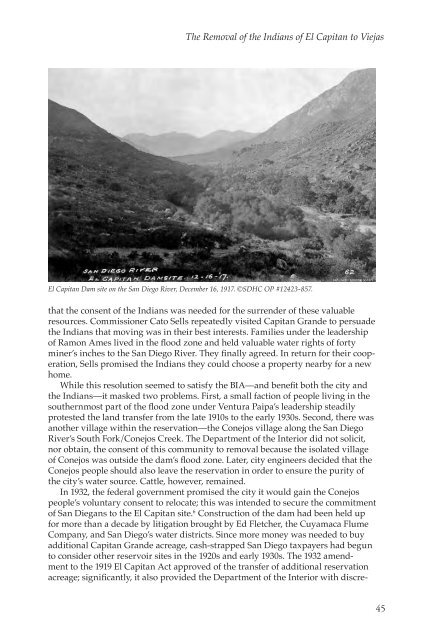You also want an ePaper? Increase the reach of your titles
YUMPU automatically turns print PDFs into web optimized ePapers that Google loves.
The Removal of the Indians of El Capitan to Viejas<br />
El Capitan Dam site on the <strong>San</strong> <strong>Diego</strong> River, December 16, 1917. ©SDHC OP #12423-857.<br />
that the consent of the Indians was needed for the surrender of these valuable<br />
resources. Commissioner Cato Sells repeatedly visited Capitan Grande to persuade<br />
the Indians that moving was in their best interests. Families under the leadership<br />
of Ramon Ames lived in the flood zone and held valuable water rights of forty<br />
miner’s inches to the <strong>San</strong> <strong>Diego</strong> River. They finally agreed. In return for their cooperation,<br />
Sells promised the Indians they could choose a property nearby for a new<br />
home.<br />
While this resolution seemed to satisfy the BIA—and benefit both the city and<br />
the Indians—it masked two problems. First, a small faction of people living in the<br />
southernmost part of the flood zone under Ventura Paipa’s leadership steadily<br />
protested the land transfer from the late 1910s to the early 1930s. Second, there was<br />
another village within the reservation—the Conejos village along the <strong>San</strong> <strong>Diego</strong><br />
River’s South Fork/Conejos Creek. The Department of the Interior did not solicit,<br />
nor obtain, the consent of this community to removal because the isolated village<br />
of Conejos was outside the dam’s flood zone. Later, city engineers decided that the<br />
Conejos people should also leave the reservation in order to ensure the purity of<br />
the city’s water source. Cattle, however, remained.<br />
In 1932, the federal government promised the city it would gain the Conejos<br />
people’s voluntary consent to relocate; this was intended to secure the commitment<br />
of <strong>San</strong> Diegans to the El Capitan site. 6 Construction of the dam had been held up<br />
for more than a decade by litigation brought by Ed Fletcher, the Cuyamaca Flume<br />
Company, and <strong>San</strong> <strong>Diego</strong>’s water districts. Since more money was needed to buy<br />
additional Capitan Grande acreage, cash-strapped <strong>San</strong> <strong>Diego</strong> taxpayers had begun<br />
to consider other reservoir sites in the 1920s and early 1930s. The 1932 amendment<br />
to the 1919 El Capitan Act approved of the transfer of additional reservation<br />
acreage; significantly, it also provided the Department of the Interior with discre-<br />
45







![[PDF] The Journal of San Diego History Vol 52: Nos 1 & 2](https://img.yumpu.com/25984149/1/172x260/pdf-the-journal-of-san-diego-history-vol-52-nos-1-2.jpg?quality=85)

![[PDF] The Journal of San Diego History - San Diego History Center](https://img.yumpu.com/25984131/1/172x260/pdf-the-journal-of-san-diego-history-san-diego-history-center.jpg?quality=85)






